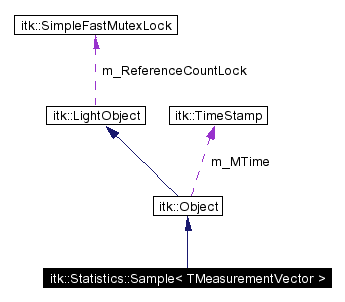
#include <itkSample.h>
Inheritance diagram for itk::Statistics::Sample:


Public Types | |
| typedef Sample | Self |
| typedef Object | Superclass |
| typedef SmartPointer< Self > | Pointer |
| typedef TMeasurementVector | MeasurementVectorType |
| typedef TMeasurementVector::ValueType | MeasurementType |
| typedef float | FrequencyType |
| typedef unsigned long | InstanceIdentifier |
Public Methods | |
| virtual const char * | GetClassName () const |
| itkStaticConstMacro (MeasurementVectorSize, unsigned int, TMeasurementVector::Length) | |
| virtual unsigned int | Size () const=0 |
| virtual unsigned int | Size (const unsigned int &dimension) const=0 |
| virtual unsigned int | GetNumberOfInstances () const=0 |
| virtual MeasurementVectorType & | GetMeasurementVector (const InstanceIdentifier &id)=0 |
| virtual FrequencyType | GetFrequency (const InstanceIdentifier &id) const=0 |
| virtual FrequencyType | GetTotalFrequency (const unsigned int &dimension) const=0 |
Protected Methods | |
| Sample () | |
| virtual | ~Sample () |
| void | PrintSelf (std::ostream &os, Indent indent) const |
A measurement vector is a vector of different types of values. For example, users might have an image with each pixel have a gray level intensity value and a gradient magnitude. In this example, user think each pixel as a measurement vector that has two types of values, intensity and gradient magnitude. In this sense, the meaning of "measurement" can be interchaneable with "measurement".
The primary purpose of Sample clases are storing such measurement vectors and providing different types of element access methods.
The "TMeasurement" template argument defines the type of each values in a measurement vector. The "VMeasurementVectorSize" template argument defines the number of elements in a measurement vector. The type of measurement vector is fixed as ITK Point. The resulting measurement vector type is Point< TMeasurement, VMeasurementVectorSize >.
There are two common ways of accessing data. First, users can use an "InstanceIdentifier", say 'id' which is sequential index of measurement vectors to access a measurement vector in a container. Second, users can access a measurement value using dimension and the index of a measurement value, say 'n' in that dimension. The 'id' and 'n' is equal in the ListSample classes. However, in Histogram class, its different. See Histogram. For algorithms using these indexes, there are methods to get the length of each dimension, GetSize() and GetSize(dimension). See each method's comment.
Users may need to know two other groups of methods to fully utilize Sample. One group of methods is about frequency of measurement vectors. In Histogram classes, you can use such methods to get/set the frequency of each measurement vector. The other group of methods is about characteristics of each subclasses of this class. If user want to create or know the characteristics of a subclass, use them. The set of characteristics tell that if the data is sorted (true for Histogram), if the each measurement vector is unique (true for Histogram), and if the container supports "meaningful" frequency interfaces. In ListSample classes, users cannot set frequency, and GetFrequency() methods return one if the element exists, else zero. So, currently ListSample's supporting frequency is set to false.
Definition at line 75 of file itkSample.h.
|
|||||
|
|||||
|
Instance Identifier typedef support this identifier will be unique sequential id for each measurement vector in a Sample subclass. Reimplemented in itk::Statistics::Histogram< TMeasurement, VMeasurementVectorSize, TFrequencyContainer >, itk::Statistics::ImageToListAdaptor< TImage >, itk::Statistics::ListSample< TMeasurementVector >, itk::Statistics::ListSampleBase< TMeasurementVector >, itk::Statistics::MembershipSample< TSample >, itk::Statistics::PointSetToListAdaptor< TPointSet >, itk::Statistics::Subsample< TSample >, itk::Statistics::Histogram< THistogramMeasurement, 1 >, itk::Statistics::ListSampleBase< TImage::PixelType >, and itk::Statistics::ListSampleBase< TPointSet::PointType >. Definition at line 102 of file itkSample.h. |
|
|||||
|
|||||
|
|||||
|
|||||
|
|||||
|
|||||||||
|
Definition at line 119 of file itkSample.h. |
|
|||||||||
|
Definition at line 120 of file itkSample.h. |
|
|||||||||
|
||||||||||
|
returns the frequency of the instance which is identified by the 'id' Implemented in itk::Statistics::Histogram< TMeasurement, VMeasurementVectorSize, TFrequencyContainer >, itk::Statistics::ImageToListAdaptor< TImage >, itk::Statistics::ListSample< TMeasurementVector >, itk::Statistics::MembershipSample< TSample >, itk::Statistics::PointSetToListAdaptor< TPointSet >, itk::Statistics::Subsample< TSample >, and itk::Statistics::Histogram< THistogramMeasurement, 1 >. |
|
||||||||||
|
retunrs the measurement of the instance which is identified by the 'id' Implemented in itk::Statistics::Histogram< TMeasurement, VMeasurementVectorSize, TFrequencyContainer >, itk::Statistics::ImageToListAdaptor< TImage >, itk::Statistics::ListSample< TMeasurementVector >, itk::Statistics::MembershipSample< TSample >, itk::Statistics::PointSetToListAdaptor< TPointSet >, itk::Statistics::Subsample< TSample >, and itk::Statistics::Histogram< THistogramMeasurement, 1 >. |
|
|||||||||
|
||||||||||
|
||||||||||||||||||||
|
Alias for the number of measurement vector components Reimplemented in itk::Statistics::ListSampleBase< TMeasurementVector >, itk::Statistics::ListSampleBase< TImage::PixelType >, and itk::Statistics::ListSampleBase< TPointSet::PointType >. |
|
||||||||||||||||
|
Methods invoked by Print() to print information about the object including superclasses. Typically not called by the user (use Print() instead) but used in the hierarchical print process to combine the output of several classes. Reimplemented from itk::Object. Reimplemented in itk::Statistics::Histogram< TMeasurement, VMeasurementVectorSize, TFrequencyContainer >, itk::Statistics::ImageToListAdaptor< TImage >, itk::Statistics::ListSample< TMeasurementVector >, itk::Statistics::MembershipSample< TSample >, itk::Statistics::PointSetToListAdaptor< TPointSet >, itk::Statistics::Subsample< TSample >, and itk::Statistics::Histogram< THistogramMeasurement, 1 >. Definition at line 121 of file itkSample.h. |
|
||||||||||
|
|||||||||
 1.2.15 written by Dimitri van Heesch,
© 1997-2000
1.2.15 written by Dimitri van Heesch,
© 1997-2000